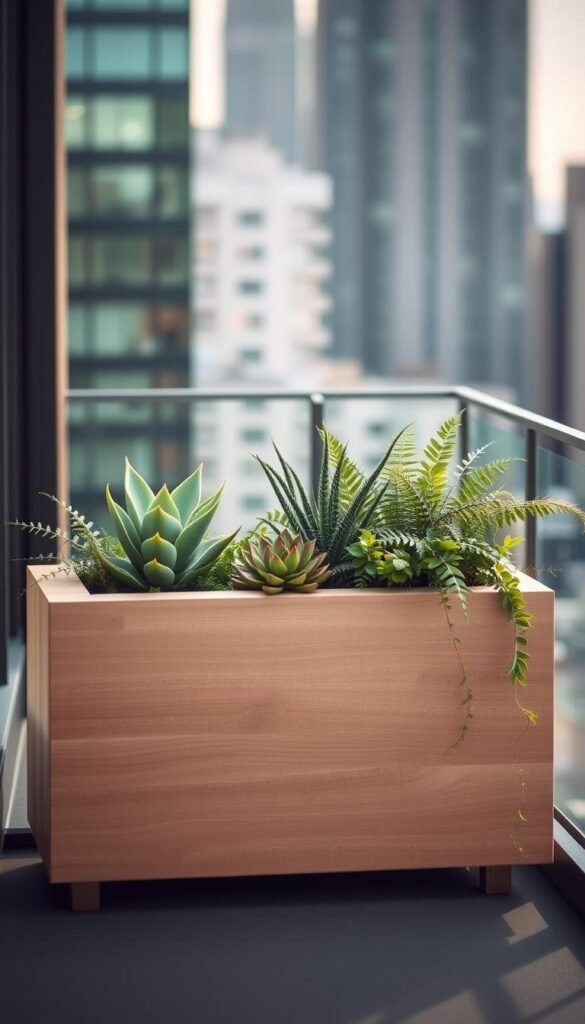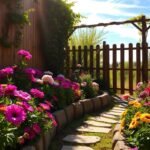Living in a bustling urban area doesn’t mean you have to give up on greenery. Whether you’re working long hours or juggling a packed schedule, creating a vibrant outdoor space is easier than you think. With the right tools, even a tiny balcony or porch can become a thriving spot for fresh herbs, colorful blooms, or homegrown veggies.
Compact planter boxes are designed to fit snugly into tight corners while requiring minimal care. They’re perfect for adding life to concrete jungles without demanding hours of watering or pruning. You’ll find options for every style—from sleek, modern designs to rustic wooden setups—so your garden can reflect your personality.
Love DIY projects? Build your own box using weather-resistant materials like cedar or metal. Prefer ready-to-use solutions? Many brands offer self-watering systems or modular designs that simplify plant care. Either way, you’ll save time and energy while enjoying the joy of homegrown flavors or a daily dose of nature.
Imagine stepping outside to pluck basil for dinner or unwinding beside a cascade of petunias after a hectic day. These space-smart solutions prove that even the busiest city dwellers can cultivate a slice of serenity. Let’s explore how to turn your limited area into a lush, lively retreat.
Understanding Urban Gardening and Its Unique Challenges
Growing plants in the heart of a metropolis isn’t just about aesthetics—it’s a creative puzzle. Limited spaces like balconies or fire escapes force you to rethink traditional gardening. But with smart strategies, even the tiniest nook can burst with life.
Overcoming Space Constraints
Vertical solutions are your best friend when square footage is scarce. Hanging planters or wall-mounted boxes let you grow upward without cluttering walkways. Always check weight limits—many buildings restrict heavy setups, especially on railings. For stability, use reinforced brackets and lightweight soil mixes.
Modular designs work wonders here. Stackable pots or tiered stands let you customize layouts based on your available area. Pair these with low-maintenance plants that thrive in tight quarters, like succulents or dwarf herbs.
Maximizing Sunlight Exposure
Sunlight is gold in shaded urban gardens. Track how light moves across your space throughout the day. South-facing spots often get the most sun, but reflective surfaces like white walls or mirrors can amplify brightness.
Rotate planters weekly to ensure even growth. If natural light is scarce, consider shade-tolerant species like ferns or snake plants. Remember: healthy roots need drainage, so always choose containers with holes to prevent waterlogged soil.
Benefits of Container Gardening in the City
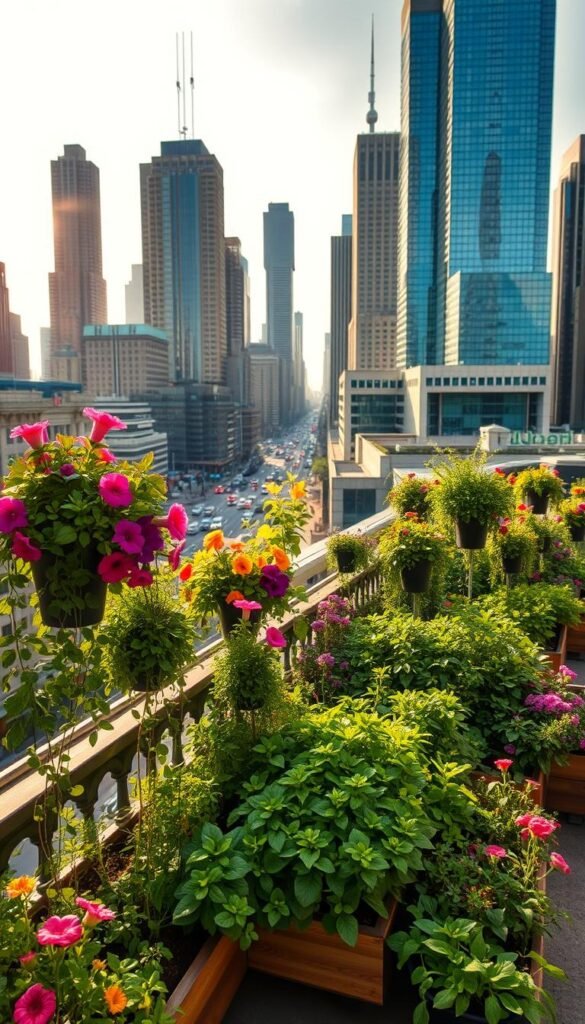
Container gardening brings nature’s perks to even the smallest urban corners. Unlike traditional garden beds, these portable setups let you curate soil quality and moisture levels for healthier plants. You’re not just growing greenery—you’re crafting a living filter that softens traffic noise and purifies air.
Environmental and Aesthetic Advantages
Compact planters turn bland walls or balconies into vibrant ecosystems. They absorb carbon dioxide while adding pops of color to gray landscapes. Self-watering designs, like those from brands such as Gardyn, simplify care while conserving resources.
Grouping plants in clusters creates natural sound barriers. A mix of tall grasses and trailing ivy in modular containers can transform a noisy patio into a peaceful retreat. Plus, you control pests without harsh chemicals—a win for local ecosystems.
Flexibility and Mobility for Your Plants
Move planters to chase sunlight or shield delicate fresh herbs from afternoon heat. Rotate pots seasonally—swap summer blooms for frost-resistant evergreens without replanting. Hanging solutions keep pathways clear while maximizing vertical space.
This adaptability lets you experiment. Try a mobile herb cart near your kitchen window or lightweight fiberglass boxes on wheels. Your garden evolves with your life, proving that urban spaces can be both functional and flourishing.
Low-Maintenance Planter Boxes for Busy City Dwellers
In the rhythm of city life, simplicity in design meets nature’s resilience. These planter boxes eliminate guesswork with built-in features like self-watering reservoirs and drainage layers. You won’t need to babysit your plants—just fill the system weekly and let it handle the rest.
Durable wood options, like cedar or teak, resist rot and pests while aging gracefully. Recycled composite materials offer similar toughness with a lighter feel—ideal for rooftop setups. Many designs include pre-drilled holes or snap-together panels, letting you assemble them in minutes without tools.
Smart engineering shines in modular units that expand as your gardening ambitions grow. Pair stackable tiers with cascading flowers for instant vertical impact. In spring, mix vibrant pansies with fragrant herbs to create a sensory oasis that thrives with minimal effort.
These solutions aren’t just practical—they’re style statements. Sleek metal finishes or weathered wood textures add character to concrete backdrops. Whether you’re nurturing basil for cocktails or dahlias for joy, your urban retreat stays lush without demanding your weekends.
Selecting the Ideal Planter for Your Urban Space
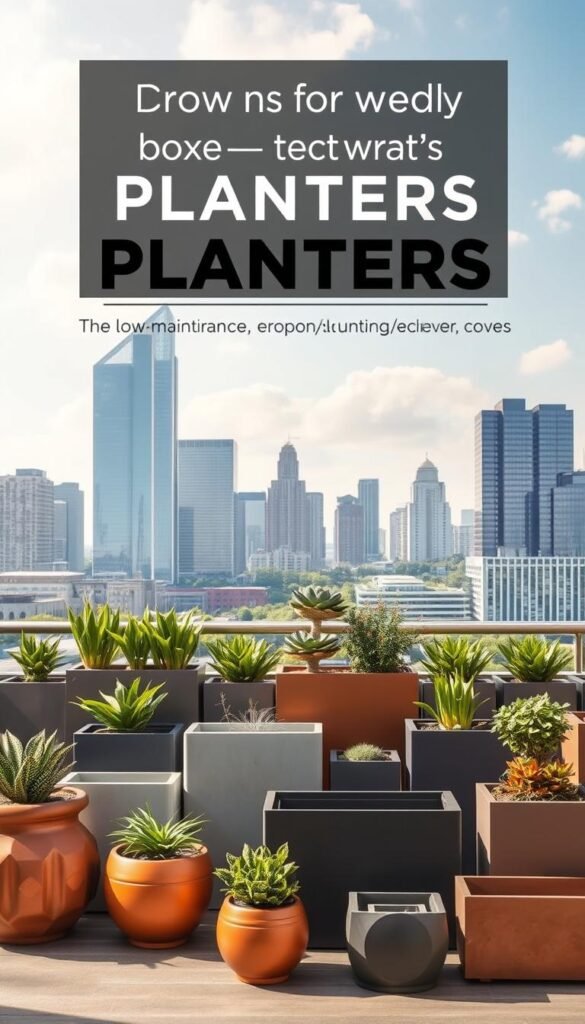
Your urban garden starts with the right planter—one that fits both your space and style. Whether you’re working with a narrow balcony or a sunny stoop, smart choices ensure your plants thrive without overwhelming your routine.
Assessing Your Available Space
Start by measuring your area. Note railing heights, floor space, and sunlight patterns. Apartments often have weight limits—check if your building restricts heavy planter boxes on balconies.
For tight corners, slim vertical designs save room. Wider porches? Try rectangular troughs for herbs or flowers. Always prioritize drainage holes and weather-resistant materials like powder-coated steel or UV-stable resin.
| Location | Planter Size | Best For | Material Tip |
|---|---|---|---|
| Balcony | Compact (12-18″) | Herbs/succulents | Fiberglass |
| Front Porch | Large (24-36″) | Tomatoes/flowers | Cedar wood |
| Windowsill | Narrow (6-8″) | Microgreens | Recycled plastic |
Matching Your Gardening Goals with the Right Design
Want fresh herbs for cooking? Shallow window boxes with basil and thyme work perfectly. Prefer bold visuals? Tiered planters with cascading petunias create instant impact.
Modular systems like GreenStalk let you stack spaces vertically. For veggies, choose deep-rooted planter boxes (18″+ depth). Pair sleek metal troughs with architectural plants for a modern vibe, or use rustic wood crates for cottage charm.
Remember: Your container’s design should solve problems, not create them. A rolling cart makes repositioning easy, while self-watering inserts cut down on daily care.
Innovative Self-Watering Systems for Hassle-Free Gardening
Forgetting to water plants becomes a non-issue with self-watering systems designed for urban lifestyles. These smart planter boxes use clever engineering to keep soil moist for days, even when your schedule gets chaotic. They’re game-changers for anyone craving greenery without daily upkeep.
How Self-Watering Works for Busy Gardeners
At their core, these systems rely on capillary action. A water reservoir sits beneath the soil, connected by a wicking mechanism—like felt strips or porous clay—that draws moisture upward. Your plants drink what they need, avoiding root rot from overwatering.
Most models only need refilling every 7-10 days. Brands like Garden Tower 2 take it further with vertical stacking and compost integration. You’ll spend less time hauling watering cans and more enjoying your garden.
Top Self-Watering Planter Models to Consider
The Urban Pot planter shines with its sleek, space-saving shape and 2-gallon reservoir. Its modular design lets you link multiple units for cascading herbs or flowers. For larger yields, the Garden Tower 2 supports 50 plants across five tiers while recycling nutrients from built-in compost tubes.
These systems cut maintenance by 60% compared to traditional container gardening. Pair them with moisture-loving crops like lettuce or mint for best results. Your balcony stays vibrant, even during back-to-back work weeks.
Ready to simplify plant care? Self-watering tech turns unpredictable routines into thriving green spaces. Your urban oasis stays lush while you focus on life’s other adventures.
Maximizing Vertical Space with Hanging and Railing Planters
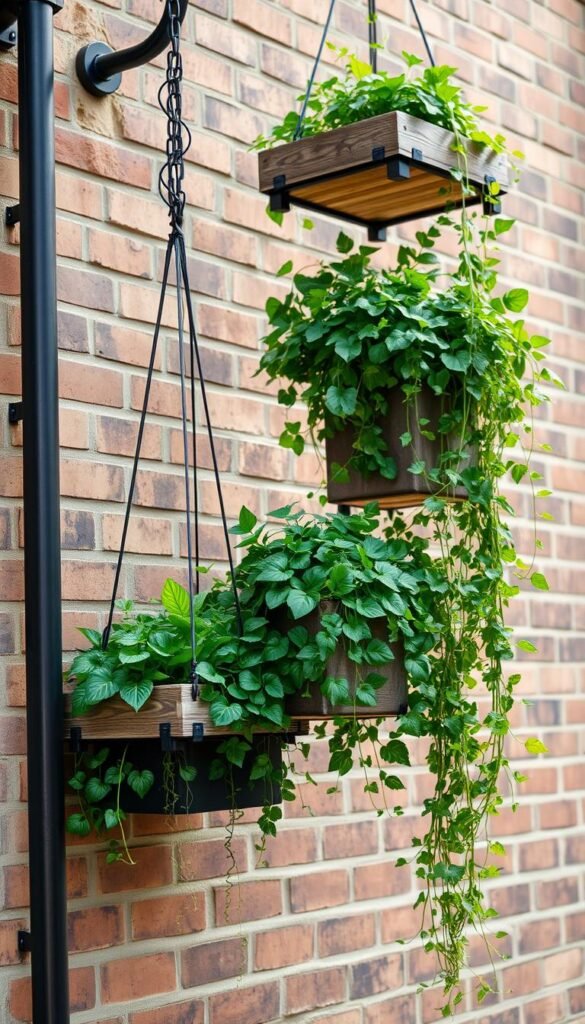
Elevate your urban gardening game by looking up—literally. Walls, railings, and ceilings offer untapped potential for growing lush greenery without sacrificing precious floor spaces. Hanging planters and railing-mounted designs turn blank surfaces into living art while keeping pathways clear.
Installation Tips for Secure Setup
Start by choosing hardware that matches your surface. For metal railings, use adjustable clamps with rubber padding to prevent scratches. Wooden balconies? Opt for screw-in brackets that distribute weight evenly. Always check load limits—a fully watered planter can weigh 3x more than when dry.
When mounting on brick or stucco walls, concrete anchors provide the strongest hold. Use a level to ensure even spacing and prevent water pooling. For windy spots, secure trailing vines with soft plant ties and add mesh liners to keep soil in place.
| Surface Type | Best Hardware | Wind Protection |
|---|---|---|
| Metal Railings | Adjustable clamps | Rubber grips |
| Wooden Walls | Lag screws | Cross-bracing |
| Concrete Balconies | Concrete anchors | Windbreak fabric |
Vertical setups shine with climbing plants like jasmine or string-of-pearls. These natural cascaders create privacy screens while softening harsh architectural lines. Pair them with compact herbs in stacked planters for a functional yet beautiful display.
Remember: Proper support prevents accidents. Reinforce heavy containers with secondary straps, and test stability by gently shaking the planter after installation. Your elevated garden will thrive—and stay put—through bustling city days.
Embracing Stackable Planters for Compact Urban Gardens
Stackable planters are revolutionizing small-space gardening by turning vertical surfaces into thriving green zones. These modular systems let you grow herbs, flowers, and veggies upward—perfect for balconies or patios where floor space is scarce. Their layered design adds visual depth while multiplying your planting capacity.
Design Ideas for Vertical Layering
Create living walls by mixing textures and colors across tiers. Try trailing plants like ivy in top layers, with compact basil or strawberries below. The Garden Tower 2 system exemplifies this approach, supporting 50 plants in just 4 square feet through its rotating planter columns.
For quick impact:
- Pair shallow-rooted lettuces with deep planters for tomatoes
- Use geometric shapes like hexagons for modern flair
- Install LED grow lights between levels for shaded areas
These systems outperform traditional garden beds in urban settings. Their portability lets you chase sunlight or rearrange layouts seasonally. Many models include self-watering features, cutting maintenance time by half compared to single-tier setups.
Looking to expand your green space? Check out our patio container gardening tips for maximizing small areas. With stackable planters, even a 3-foot-wide balcony becomes a productive oasis that grows with your ambitions.
DIY Planter Boxes: Creative and Cost-Effective Solutions
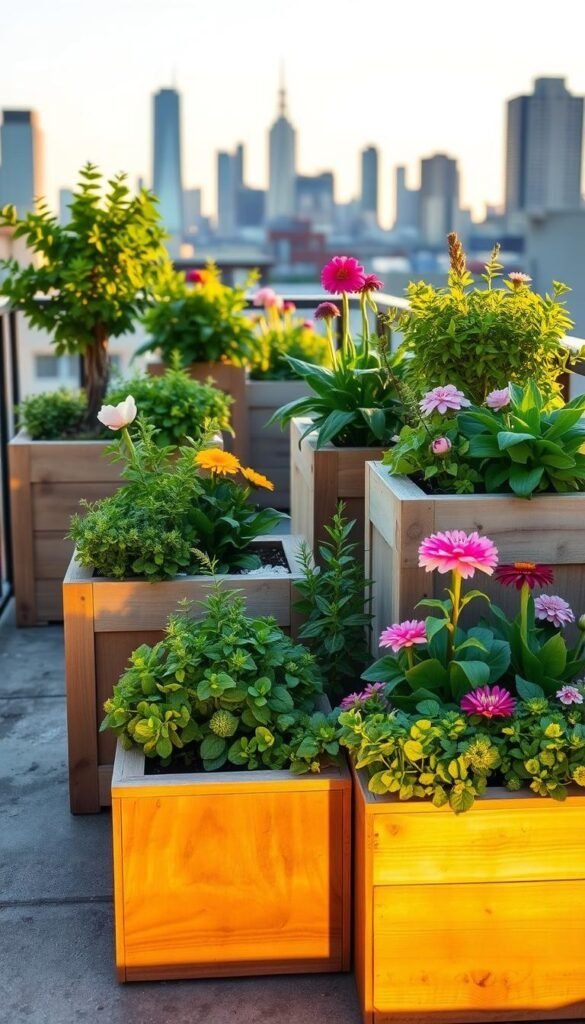
Building your own green space doesn’t require fancy tools or a big budget. With basic supplies and creativity, you can craft planter boxes that match your style while saving cash. Reclaimed wood, old crates, or leftover plywood become perfect materials for unique designs.
Simple Projects to Transform Your Space
Start with the One Plywood Sheet design—cut four equal panels and secure them with screws. Add diagonal braces for stability, then line the interior with landscape fabric. This box works great for herbs or flowering annuals.
Lattice patterns offer airflow and visual interest. Attach pre-cut lattice panels to a basic wood frame using staples or nails. Stain it walnut for a rustic vibe or paint it mint green for fresh contrast.
| Project | Materials Needed | Time Required | Skill Level |
|---|---|---|---|
| Plywood Box | 1 sheet, screws, fabric | 2 hours | Beginner |
| Lattice Planter | Wood strips, nails | 3 hours | Intermediate |
| Pallet Planter | Reclaimed pallet, saw | 90 minutes | Novice |
Personalize your creation with chalkboard labels or copper accents. Use a drill to add drainage holes if repurposing containers like tin cans. These projects turn scrap materials into functional art—proving that great design doesn’t need deep pockets.
Designing Your Container with Aesthetic Appeal
Your planter’s design transforms it from a simple pot to a statement piece that elevates your entire space. Whether you’re arranging flowers on a deck or herbs by a window, balancing beauty with practicality creates a cohesive look that reflects your personality.
Choosing Color Palettes and Finishes
Start by considering your home’s exterior. A matte black planter box adds modern contrast to white walls, while terracotta tones complement brick facades. For small spaces, light hues like sage or cream make containers feel airy and expansive.
Two-tone finishes are trending—try navy blue with gold trim for drama. If you love DIY, stencil geometric patterns onto plain wood using weatherproof paint. Remember: glossy surfaces reflect sunlight, while textured finishes hide dirt between cleanings.
Incorporating Modern Versus Rustic Elements
Sleek metal or concrete designs suit minimalist patios, paired with architectural plants like snake grass. For farmhouse charm, use distressed cedar boxes with trailing petunias. Mix materials for depth—a galvanized steel pot filled with wildflowers softens industrial edges.
| Style | Materials | Color Tips | Plant Pairings |
|---|---|---|---|
| Modern | Powder-coated metal | Monochrome tones | Succulents, ornamental grasses |
| Rustic | Reclaimed wood | Earthy neutrals | Lavender, daisies |
Accessories matter. Add woven liners to planter boxes for texture or minimalist legs for elevation. Your style choices turn functional containers into curated displays that welcome guests before they step inside.
Exploring Materials: Wood, Metal, and Beyond
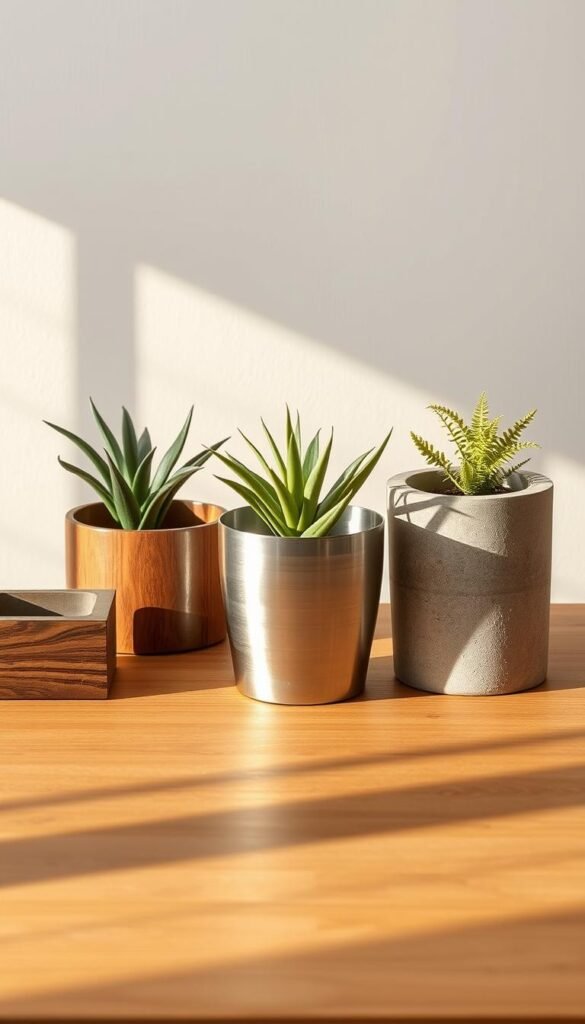
Choosing the right materials for your planters shapes both their durability and visual harmony. Your selection impacts how well your garden thrives in urban conditions—from humid summers to frosty winters.
Advantages of Wood and Reclaimed Materials
Natural wood brings warmth to concrete-heavy spaces. Cedar and redwood resist rot naturally, lasting 5-7 years untreated. Reclaimed barn wood adds rustic charm while reducing waste—perfect for eco-conscious gardeners.
Pros:
- Breathable texture prevents root rot
- Easy to customize with stains or paint
- Lightweight compared to stone
Cons include yearly sealing needs and vulnerability to termites. Use liners in wet climates to extend lifespan.
Contemporary Options with Metal and Concrete
Powder-coated steel planters handle harsh weather without fading. Their sleek profiles suit modern rooftops, while concrete’s thermal mass protects roots during temperature swings.
| Material | Best For | Climate Tip |
|---|---|---|
| Galvanized Metal | Dry regions | Add perlite to soil for insulation |
| Fiber-Reinforced Concrete | Windy areas | Elevate to prevent water pooling |
Metal heats up fast—avoid placing sun-loving herbs like cilantro in dark-colored containers. Concrete’s weight demands permanent placements but offers unmatched stability.
Your materials choice balances practicality with personal flair. Whether you lean toward earthy wood or industrial metals, each option transforms your space into a resilient green retreat.
Seasonal Planting: Thriving in Spring and Summer
As temperatures rise, your urban green space can burst with life—if you pick the right seasonal stars. Spring and summer offer endless opportunities to grow vibrant plants that thrive in warmer weather. With smart planning, you’ll enjoy fresh flavors and eye-catching colors all season long.
Best Plant Choices for Warm Weather
Heat-loving herbs like basil and rosemary flourish in sunny spots. Pair them with cherry tomatoes—compact varieties like ‘Tumbling Tom’ do well in containers. Leafy greens such as kale and Swiss chard handle early summer warmth if watered consistently.
For non-stop color, try these flowers:
- Zinnias: Drought-tolerant and butterfly-friendly
- Marigolds: Natural pest deterrents
- Petunias: Bloom profusely until frost
Check local frost dates before planting. Many low-maintenance flowers thrive in both spring and summer, making them perfect for busy schedules.
Arranging for Continuous Color and Bloom
Stagger planting times for herbs and flowers to ensure rotations. Sow quick-growers like radishes between slower plants. Use tall species like sunflowers as backdrops, with trailing nasturtiums at container edges.
Follow this heat-management checklist:
| Challenge | Solution | Plant Example |
|---|---|---|
| Midday sun | Shade cloth | Lettuce |
| Dry soil | Mulching | Thyme |
| Humidity | Airflow spacing | Peppers |
Water deeply in early morning to prevent evaporation. Group pots with similar needs—succulents with herbs, moisture-loving plants together. Your garden beds will stay lively from April through September!
Easy Maintenance Tips for the Busy Urban Gardener
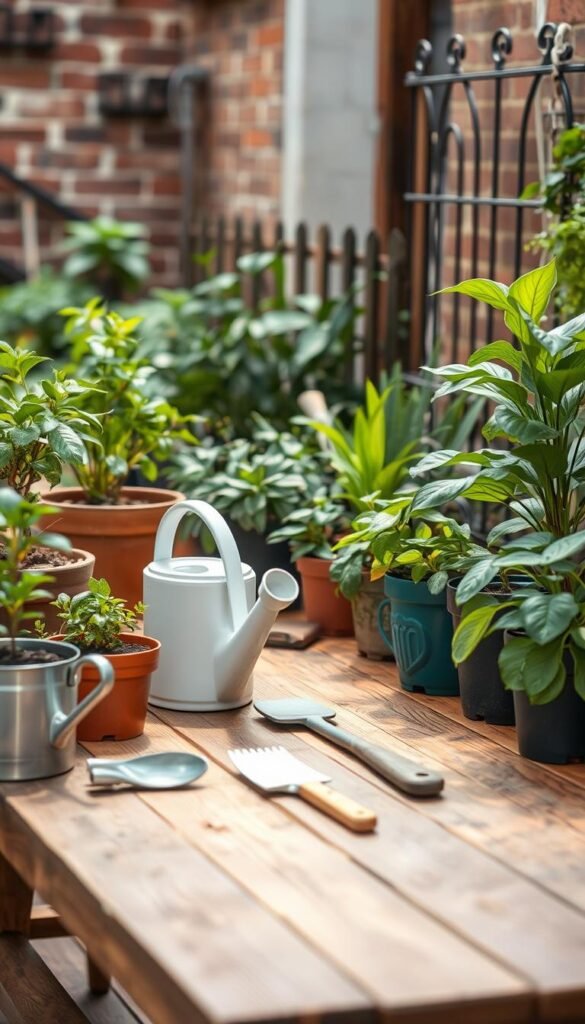
Keeping your green space thriving doesn’t have to eat up your schedule. With smart routines, even the busiest gardening enthusiast can enjoy lush plants without daily fuss. Let’s simplify care so your urban oasis stays vibrant year-round.
Watering and Fertilization Strategies
Timing is everything. Water fresh herbs and flowers early in the morning to reduce evaporation. Use a moisture meter—they’re cheap and prevent overwatering. For self-watering systems, check reservoirs weekly and top up during heatwaves.
Slow-release fertilizers save time. Mix pellets into soil during planting, and they’ll feed roots for months. Pair this with compost tea every 3 weeks for a nutrient boost. Remember: overfeeding harms more than underfeeding.
| Plant Type | Water Frequency | Fertilizer Tip |
|---|---|---|
| Herbs | Every 3 days | Balanced 10-10-10 |
| Succulents | Every 10 days | Low-nitrogen mix |
| Flowering Annuals | Every 2 days | High-phosphorus formula |
Seasonal adjustments matter. In summer, shade cloths protect pots from scorching sun. Winter? Move frost-sensitive plants indoors or use thermal covers. For more container gardening basics, explore our beginner-friendly guide.
Consistency beats perfection. A 5-minute daily check—peek at soil, prune dead leaves—keeps issues small. Your garden rewards minimal effort with maximum joy.
Real-Life Product Roundup: Top Urban Planter Picks
Ready to upgrade your green space? We’ve tested popular models and combed through hundreds of reviews to find planter boxes that balance style, durability, and ease of use. These crowd-approved picks thrive in tight spaces while keeping maintenance minimal.
Featured Models and User Reviews
The Garden Tower 2 earns rave reviews for its vertical design and built-in compost system. Users love how its 5-tier structure supports 50 plants in just 4 square feet—ideal for growing herbs and leafy greens on a sunny front porch. Its self-watering wicks reduce daily care, though some note assembly takes patience.
For sleek simplicity, the Urban Pot shines. This modular window box links multiple units to create cascading flower displays. Its powder-coated steel resists rust, and the 2-gallon reservoir lasts 10 days between refills. One reviewer called it “perfect for transforming bland railings into living art.”
| Model | Best For | Key Features | Ideal Spot |
|---|---|---|---|
| GreenStalk Vertical | Strawberries & herbs | 7-tier rotation system | Balcony corners |
| CedarCraft Trough | Tomatoes & peppers | Natural rot resistance | Sunny front porch |
| Viva+ Window Buddy | Succulents & microgreens | Magnetic mounting | Kitchen windowsill |
Don’t overlook the Vego Raised Bed—its modular panels snap together in minutes, and the 12” depth handles root veggies like carrots. Users praise its sturdy recycled plastic, though it’s best paired with casters for mobility. Whether you’re crafting a compact garden or refreshing a stoop, these solutions turn urban challenges into thriving opportunities.
Eco-Friendly and Smart Gardening Innovations
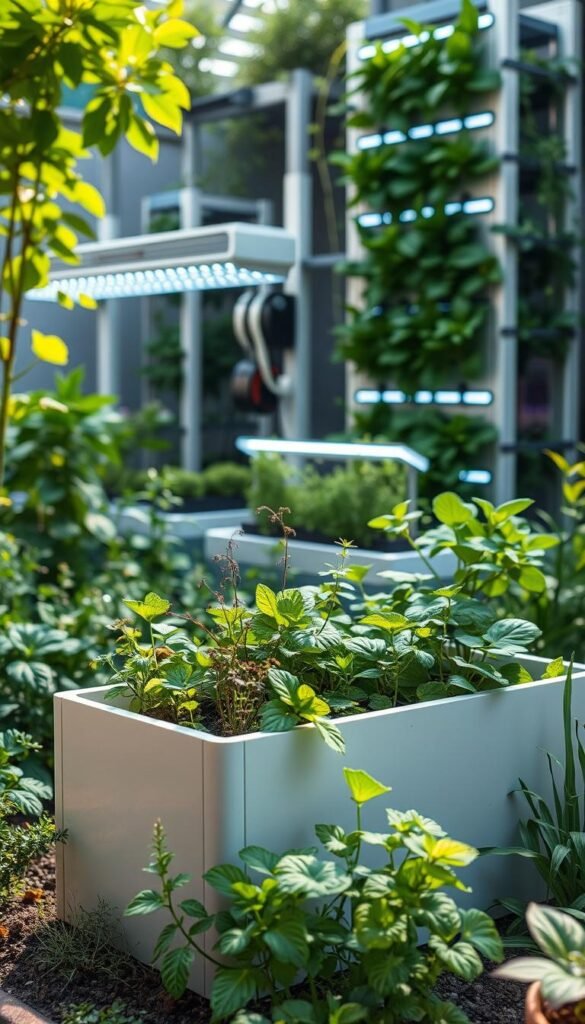
Your balcony garden just got a tech upgrade. Modern solutions blend sustainability with smart features to help you grow lush greenery effortlessly. These innovations reduce your environmental footprint while simplifying plant care through intelligent design.
Leveraging Technology in Your Garden
App-controlled systems like Rachio’s Smart Hose Timer adjust watering based on real-time weather data. Pair it with soil sensors like Parrot Flower Power to monitor moisture and nutrient levels. You’ll receive alerts when your basil needs hydration or your roses crave fertilizer.
Solar-powered planter boxes with LED grow lights extend daylight hours for herbs. The Click & Grow Smart Garden 3 uses biodegradable pods and auto-lighting to grow basil 30% faster than traditional methods. No guesswork—just fresh flavors at your fingertips.
Integrating Sustainable Practices
Choose containers made from recycled ocean plastic or reclaimed wood. Brands like EcoForms craft durable pots using rice hulls and post-consumer materials. These materials withstand urban weather while keeping waste out of landfills.
| Eco Feature | Benefit | Example Product |
|---|---|---|
| Self-watering wicks | Cuts water use by 40% | EarthBox Organic |
| Compost integration | Eliminates synthetic fertilizers | Garden Tower 2 |
| Solar charging | Zero-energy lighting | SolTech Grow Light |
Combine these tools with rainwater collection barrels for a closed-loop system. Your gardening routine becomes a force for good—nurturing plants while protecting urban ecosystems. Smart tech meets earth-friendly values in your pocket-sized paradise.
Personalizing Your Planter Box for a Unique Look
Your planter box isn’t just a home for plants—it’s a canvas waiting for your creative touch. Whether you’re drawn to bold patterns or subtle textures, customization lets your green space reflect what makes you unique. Start by thinking beyond basic pots and explore finishes, accents, and layouts that elevate your outdoor décor.
Customizations and Decorative Accents
Transform plain containers into eye-catching pieces with these ideas:
- Paint & Patterns: Use weatherproof acrylics to add stripes, ombré effects, or geometric shapes. Stencils simplify intricate designs like Moroccan tiles or floral motifs.
- Mixed Materials: Attach reclaimed wood slats to metal frames for rustic-industrial contrast. Try mosaic tiles along the edges for a pop of color.
- Functional Decor: Add copper wire trellises for climbing vines or attach small hooks to hang garden tools.
Balance aesthetics with practicality. For example, a hand-painted planter box paired with drought-tolerant flowers like lavender keeps maintenance low while maximizing visual impact. If you’re looking for inspiration, check out DIY blogs where crafters combine modern concrete planters with vintage hardware.
Don’t shy away from seasonal updates. Swap out autumn-themed decals for springtime botanicals, or wrap burlap around pots during winter for cozy texture. Your design choices turn everyday containers into conversation starters that grow alongside your plants.
Final Thoughts on Crafting Your Urban Oasis
Transforming your concrete surroundings into a green haven is simpler than it seems. With smart planter boxes and clever design, even the tiniest balcony can become a thriving garden. The right materials and self-watering systems let you grow fresh herbs or colorful blooms without constant attention.
Remember: your space reflects your style. Sleek metal planters suit modern aesthetics, while reclaimed wood adds rustic charm. Brands like Garden Tower 2 prove that vertical solutions maximize yields in tight areas—perfect for urban gardeners craving both function and beauty.
Start small. A single window box of basil or a hanging succulent display builds confidence. As you experiment, you’ll discover how effortless greenery elevates daily life. Your personalized oasis awaits—one that thrives alongside your schedule.
Ready to begin? Grab a planter box, pick your favorite plants, and let nature soften your city view. The beauty of urban gardening lies not in perfection, but in the joy of watching life unfold—one leaf at a time.

